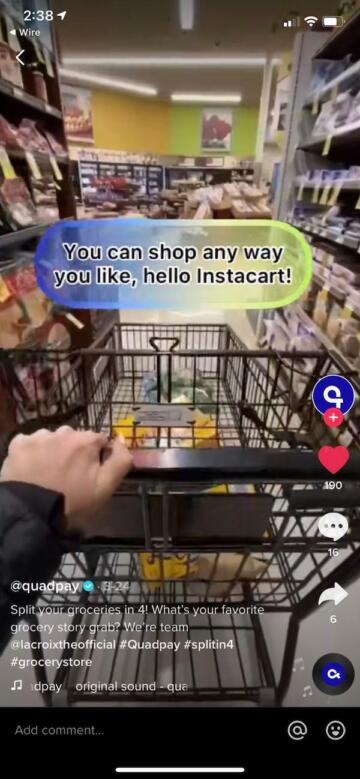If you’ve scrolled through any e-commerce sites lately, you’ve probably seen a version of it: A charming dinner plate costs $28 or “4 interest-free installments of $7.00 by Afterpay.” A pastoral checkered dress could run you $74.50 … or, alternatively, “4 interest-free payments of $18.62 with Klarna.”
In the past year, more and more merchants have started incorporating “buy now, pay later” options into their websites. They’re often prominently featured on product pages, where shoppers who might otherwise click away are encouraged to instead splurge and split their spending into periodic payments.
Major fashion retailers like Macy’s and Neiman Marcus have integrated these payment options into their online stores, but nice clothes and china aren’t the only items shoppers are increasingly enticed to purchase in parts. Parents can now pay for their kids’ football clinics in installments using Sezzle. One lender, Quadpay, posted a TikTok encouraging people to take out installment loans to pay for groceries, framing the advice as “the world’s biggest secret.”
Shira Schwartz, Quadpay’s vice president of marketing, said in a written statement, “There is a narrative that BNPL is only meant for splurges or luxuries, but we have seen many consumers leverage Quadpay to expand their spending power for things like groceries, personal care and other essentials, for better cash flow management, particularly during COVID-19.”
On its website, Quadpay also advertises paying for plane tickets and ride-hail services through its app. Quadpay and other BNPL companies, like Klarna and Sezzle, even let shoppers make in-store purchases in installments using a virtual card.
BNPL services have grown as much as 200 percent since the pandemic, according to The Washington Post. Klarna, a Swedish startup, recently raised $639 million and currently has a valuation of more than $40 billion, according to TechCrunch. Affirm, another BNPL lender, held an IPO at the beginning of the year and raised at least $1.2 billion, according to MarketWatch. Apple recently announced that it would be launching its own version with Goldman Sachs.
While BNPL companies present these loans as a smart budgeting tool, experts say costs can quickly add up, leaving shoppers with mounting debt. And regulators across the world have started to rein in these services, concerned that they can negatively impact the young consumers who tend to use them.
“Because of the ease of access to credit, the danger is that somebody who is borrowing may not be in the best position to borrow, and therefore they could be putting themselves in a more difficult financial position,” said Bruce McClary, the National Foundation for Credit Counseling’s (NFCC) senior vice president of communications.
How Does It Work?
Unlike other payment options you might see at checkout, McClary explained, using a buy now, pay later option generally “gives you a chance to access a line of credit for a specific type of purchase and pay it off in a way that is more structured, like a closed end loan.” The bar for approval is “a little more flexible than credit card companies, which may be more helpful for those with limited or no credit history.”
BNPL services ask for basic details like your name, address, and a phone number. Most services, like Klarna and Quadpay, typically do a soft credit check, which doesn’t affect your credit score and isn’t reported to other lenders.
While on the surface many of these offers can appear almost identical, the actual fine print for each company can vary widely. Martin Lynch, Cambridge Credit Counseling’s director of education, wrote in an email that “it’s best to think of these purchase options in just two ways: those with a limited time to make purchases interest-free,”—such as Klarna’s Pay in 4 option—“and those that may extend the repayment period but will assess interest in return,” including the loans offered by Affirm. Sometimes those loans are at high rates. Affirm, for example, charges customers up to 30 percent APR. According to the Consumer Finance Protection Bureau, the average credit card APR for consumers with a “deep subprime” credit score was around 20 percent in 2018.
Affirm declined to comment for this story.
Data suggests that at least in the case of this second category, the companies more often make their money from retailer commissions, not missed payments. A 2020 report by the Australian Securities & Investment Commission found that in Australia, merchant fees made up a lion’s share of those providers’ fiscal year 2018–2019 revenue.
Klarna charges vendors “up to” 5.99 percent of each transaction—a hefty price compared to popular traditional payment processor Stripe’s cut of 2.9 percent per transaction. Klarna touts “No risks. Just benefits” to retailers and promises merchants that it will cover the financial risks while increasing the amount that consumers would otherwise spend.
Quadpay, the startup encouraging TikTokers to purchase groceries on installment, makes similar promises. On its website it claims to increase conversion rates—the amount of people who actually make purchases compared to those who just visit the site—by between 10 and 20 percent and average order values by up to 70 percent.
What Are the Drawbacks?
While increased spending can be a boon for merchants, it can come at a cost to consumers.
With interest-bearing loans like Affirm’s, customers who finance large items over long periods of time can end up paying extra. For instance, Affirm’s own calculator shows that someone financing a $1,000 couch over 36 months with a 30 percent APR could end up paying $528.20 in additional interest. An SEC filing from Affirm says that while half of its 2020 revenue came from merchant fees, $186 million of its revenue came from interest on loans—a little more than a third of its total revenue for the 2020 fiscal year.
With the no-interest model, there can also be drawbacks.
The 2020 Australian ASIC report on companies who provide no-interest BNPL options found that 20 percent of consumers surveyed “cut back on or went without essentials” like meals in order to make payments on time. That percentage increased when consumers had three such arrangements in the previous six months.
Payment withdrawals for many no-interest arrangements are automatic. For most consumers, the lack of friction is convenient, but for others it can lead to disaster. Late this spring, Klarna and Afterpay were hit with class action lawsuits in the U.S. District Court for the District of Connecticut and the U.S. District Court for the Northern District of California, respectively. Both complaints alleged that the companies were engaging in deceptive practices, targeting low-income consumers living paycheck to paycheck with the promise of no interest or fees while not being upfront about the potential risk of overdraft or insufficient funds fees. The complaint against Klarna alleged that the company exacerbated issues by attempting to reprocess charges, even when it was clear that users’ checking accounts were negative.
Brendan Lewis, Klarna’s head of U.S. communications, wrote in an email, “As a matter of practice, we do not comment on the specifics of active litigation, but believe these claims are misdirected and without merit.”
Afterpay’s vice president of communications, Amanda Pires, wrote in an email, “Afterpay was built from the ground-up to help consumers avoid interest, excessive fees and falling into pernicious debt.” Pires added that “Afterpay offers a generous and accessible hardship program where flexible payment timelines, with no additional fees, can be agreed upon.”
Afterpay did not comment on the pending lawsuit.
Late payments can escalate into late fees. Sezzle lets customers reschedule payments for $5, up to three times per order. If a payment is more than two days late, the company will charge the account holder $10 and freeze their ability to make additional purchases. Lewis, the Klarna spokesperson, explained that when the company fails to collect a scheduled payment, it attempts to contact the customer. If that fails, Klarna charges a late fee of up to $7 and then tacks the failed payment onto the next scheduled one.
Sezzle did not respond to a request for comment.
72%
of Americans who missed BNPL payments saw a drop in their credit scores.
Source: Credit Karma/Qualtrics survey
Eventually failed payments can go to debt collectors. Quadpay charges a $7 late fee but will automatically send accounts to collections “after a certain time period.” (Don’t rely on customer support to tell you when that might be. According to Quadpay’s help page, “agents do not have info as to when that will happen.”) This can result in negative additions to a borrower’s credit report. A recent survey of Americans on behalf of Credit Karma found that three fourths of those who missed BNPL payments saw a drop in their credit scores.
Schwartz, the Quadpay marketing VP, said, “Less than 1 percent of our customers are late to make repayments in any given month—the number of customers seeking assistance with debt is even lower than that.”
For their part, some BNPL companies have tried to set up guardrails to prevent shopper spending from getting too out of control. If users can’t pay in time, Afterpay will adjust their future spending limits and suspend their accounts until they pay up. Lewis, the Klarna spokesperson, said that the company limits customers’ ability to use their payment programs after a missed payment.
What’s Happening to Regulate the Industry?
Governments, financial institutions, and even social media platforms have made moves to regulate the booming BNPL industry. In early 2020, the California Department of Business Oversight charged several BNPL startups with making illegal loans, and the companies agreed to stop the practice and refund California customers. The United Kingdom released a report on the industry in February and placed the Financial Conduct Authority in charge of overseeing the previously unregulated sector.
One financial institution has taken regulation into its own hands. In December, Reuters reported that Capital One banned its credit card holders from spending on BNPL loans with their credit cards, claiming to Reuters that “the transactions bear unacceptable risk.”
Attempts to rein in the advertising of BNPL products have been made as well. This month, FT Adviser reported that TikTok updated its Branded Content Policy to ban influencers from posting paid content promoting financial services and products, including BNPL services. This means that companies like Afterpay will no longer be able to partner with influencers to produce TikToks that feature BNPL services as a “college money hack” to young consumers.
Last summer, Sweden enacted the E-Commerce Payments Bill, which requires online shoppers to be presented with debit options before credit ones when checking out. The February U.K. report highlighted the law as a regulatory approach to the BNPL industry. The idea behind the law is that purchasing something on credit “should be the result of an active choice by the consumer,” according to preparatory documents reviewed by the law firm Bird & Bird.
McClary, the NFCC VP, pointed out that for some, the quick and easy access to instant credit that BNPL provides can remove the “buffer between the moment of purchase and the ability to decide whether it’s best for their circumstances. I think there’s a danger there.”






